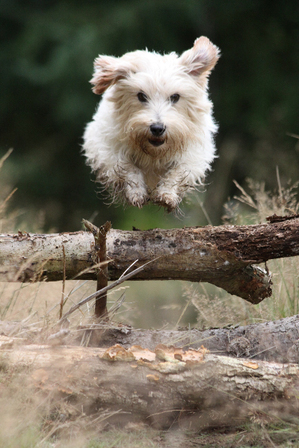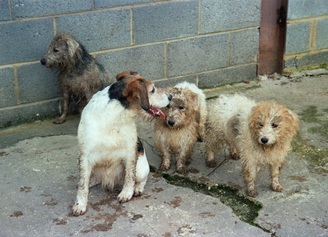
Working Role: To hunt ground vermin, going to ground when required.
General Appearance: A small, sturdy, stiff coated, compact but free moving, well boned, strong headed working terrier, roughly a foot high, with either a mainly white jacket and darker coloured patches, or, a dark coloured coat with small white markings, usually with a docked tail.
Characteristics: Determined, self-confident, lively, bustling, alert, sharp eyed, spirited, keen to hunt, fearless but not foolhardy, physically robust, active without being hyperactive, independent minded yet responsive to training and commands.
Temperament: Friendly by nature; extrovert but not dog aggressive or prone to give tongue without good reason; not immediately welcoming with strangers but not immediately submissive either; stable, lacking the excessive excitability of some other small terrier breeds.
General Appearance: A small, sturdy, stiff coated, compact but free moving, well boned, strong headed working terrier, roughly a foot high, with either a mainly white jacket and darker coloured patches, or, a dark coloured coat with small white markings, usually with a docked tail.
Characteristics: Determined, self-confident, lively, bustling, alert, sharp eyed, spirited, keen to hunt, fearless but not foolhardy, physically robust, active without being hyperactive, independent minded yet responsive to training and commands.
Temperament: Friendly by nature; extrovert but not dog aggressive or prone to give tongue without good reason; not immediately welcoming with strangers but not immediately submissive either; stable, lacking the excessive excitability of some other small terrier breeds.

Aptitude: Willing to hunt ground vermin, above and below ground. Perseveres in difficult working conditions. Displays no hesitation in tackling ground quarry, without being too hard or oblivious to instruction. Has an offensive approach without ever being out of control.
Construction: Must have the anatomy of a working terrier: a flexible spine, a powerful jaw, sturdy legs, strong but never heavy bone, ample chest room without too much “spread” in front, sound feet with well formed pads and strong toe nails.
Forefront: The head is strongly made, well boned, broad with good width between the ears and a well defined “stop”; the muzzle length measures roughly two thirds the distance from the occiput or peak to the stop, giving a strong, tapering jaw, still broad at the nose; the jaws close in a scissor bite, with strong even teeth; the jaws are built for biting and gripping, equally strong in upper and lower jaw. The skull size is in proportion to the dog’s size, lacking the heavier Sealyham head. The ears are set high, well apart, neat and V-shaped, but with slightly rounded tips, carried close to the head, dropping forward even when the dog is alert (half prick). The eyes are oval, dark, quite deep set and fairly wide apart. The lips are tight, with dark pigmentation. The neck is strongly made, of good length, slightly arched, blending well into the shoulder construction.
Forehand: The shoulder blades and upper arm are of sufficient length and angle to permit a free front stride with good extension and ample reach of neck the abbreviated restricted front action of many small terrier breeds is not desired. The elbows fit closely but allow free forward movement. The forelegs should be straight when viewed from the front, not over boned but discernibly muscled. The forefeet are small but still good sized, round, with strong robust pads, sturdy toes and strong nails.
Construction: Must have the anatomy of a working terrier: a flexible spine, a powerful jaw, sturdy legs, strong but never heavy bone, ample chest room without too much “spread” in front, sound feet with well formed pads and strong toe nails.
Forefront: The head is strongly made, well boned, broad with good width between the ears and a well defined “stop”; the muzzle length measures roughly two thirds the distance from the occiput or peak to the stop, giving a strong, tapering jaw, still broad at the nose; the jaws close in a scissor bite, with strong even teeth; the jaws are built for biting and gripping, equally strong in upper and lower jaw. The skull size is in proportion to the dog’s size, lacking the heavier Sealyham head. The ears are set high, well apart, neat and V-shaped, but with slightly rounded tips, carried close to the head, dropping forward even when the dog is alert (half prick). The eyes are oval, dark, quite deep set and fairly wide apart. The lips are tight, with dark pigmentation. The neck is strongly made, of good length, slightly arched, blending well into the shoulder construction.
Forehand: The shoulder blades and upper arm are of sufficient length and angle to permit a free front stride with good extension and ample reach of neck the abbreviated restricted front action of many small terrier breeds is not desired. The elbows fit closely but allow free forward movement. The forelegs should be straight when viewed from the front, not over boned but discernibly muscled. The forefeet are small but still good sized, round, with strong robust pads, sturdy toes and strong nails.

Torso: The chest displays obvious breadth, with well
sprung ribs carried well back. In profile the dog is oblong not square in outline. The topline is level; the body length indicating symmetry and balance, based on a lower station. The loins are supple and strong. Great flexibility in the body is desirable. The short rigid back of many show terriers is a handicap to a working dog. The underline shows a very slight tuck up.
Hind hand: The tail is set level with the topline, which slopes very slightly downwards at the croup; the tail is carried erect but not set too high. Pelvic angulation, turn of stifle and angulation at the hock must allow good forward reach when working underground and ample rear extension on the move, avoiding the short stepping,’ chopping rear leg action, lacking stride, of many small terriers. The hindquarters are not broad across the hips but well muscled. The hind legs are straight when seen from behind. The hind feet are small, round and compact, with strong, tough pads, toes and nails. The tail is normally docked to just less than four inches.
Movement: Purposeful with a low drive and a good stride, fore and aft, indicating well laid shoulders and correctly constructed hindquarters. The style is brisk, full of enthusiasm; the whole impression is one of perky assertiveness, supple strength and physical harmony.
Coat Colour: There are two main combinations: White bodied, with markings of any shade of brown, grizzle or badger grey, and black, with or without tan.Coloured, any shade of brown, black and tan or grizzle and tan. Small white markings are acceptable on the chest, brisket and feet.
Coat Texture: Harsh and stiff, straight, lying close to the body with a thick dense undercoat. A soft undercoat or too much length is not desired, 1½” being the optimum.
Dimensions: Height at the withers; 11-13”for dogs, 10-12″ for bitches. Weight 14-181bs for dogs, 11-151bs for bitches.
Faults: Unwillingness to go underground. Excessive hardness. Cloddy build, lacking flexibility. Short neck, so often in sequence with steep shoulders. Prick ears. Box Sealyham head. Barrel chest. Lack of extension fore and aft when on the move, giving the abbreviated stride of the show ring terrier breeds.
Breed Registrar is Terry Murray - who should be contacted for information about breeders and possible puppy availability. Email: foxflush@googlemail.com
Hind hand: The tail is set level with the topline, which slopes very slightly downwards at the croup; the tail is carried erect but not set too high. Pelvic angulation, turn of stifle and angulation at the hock must allow good forward reach when working underground and ample rear extension on the move, avoiding the short stepping,’ chopping rear leg action, lacking stride, of many small terriers. The hindquarters are not broad across the hips but well muscled. The hind legs are straight when seen from behind. The hind feet are small, round and compact, with strong, tough pads, toes and nails. The tail is normally docked to just less than four inches.
Movement: Purposeful with a low drive and a good stride, fore and aft, indicating well laid shoulders and correctly constructed hindquarters. The style is brisk, full of enthusiasm; the whole impression is one of perky assertiveness, supple strength and physical harmony.
Coat Colour: There are two main combinations: White bodied, with markings of any shade of brown, grizzle or badger grey, and black, with or without tan.Coloured, any shade of brown, black and tan or grizzle and tan. Small white markings are acceptable on the chest, brisket and feet.
Coat Texture: Harsh and stiff, straight, lying close to the body with a thick dense undercoat. A soft undercoat or too much length is not desired, 1½” being the optimum.
Dimensions: Height at the withers; 11-13”for dogs, 10-12″ for bitches. Weight 14-181bs for dogs, 11-151bs for bitches.
Faults: Unwillingness to go underground. Excessive hardness. Cloddy build, lacking flexibility. Short neck, so often in sequence with steep shoulders. Prick ears. Box Sealyham head. Barrel chest. Lack of extension fore and aft when on the move, giving the abbreviated stride of the show ring terrier breeds.
Breed Registrar is Terry Murray - who should be contacted for information about breeders and possible puppy availability. Email: foxflush@googlemail.com
